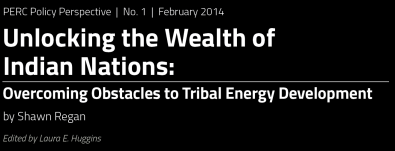Fresh off the heels of my post earlier this week highlighting the support of coal development by the president of The Northern Cheyenne Tribe in Montana, a new PERC report highlights the financial prospects for Indian Country.

Here’s a sample of the must-read 22 page report:
The Southern Ute Tribe in Colorado, for example, has experienced tremendous success developing its energy resources. The tribe owns and operates five energy companies and invests its energy revenues in a growth fund estimated to be worth $4 billion. Today, the tribe’s 1,400 members are each worth millions and receive
dividends every year from the growth fund. The tribe’s expertise in energy development extends far beyond the reservation’s borders. Red Willow Production Co., a tribal-owned energy company, is engaged in oil, gas, and coal-bed methane extraction throughout the western United States, as well as offshore oil production in the Gulf of Mexico.In 2013, the Navajo Nation purchased the Navajo Mine,
the sole provider of coal to New Mexico’s Four Corners Generating Station. The mine has provided jobs to hundreds of tribal members and generates $41 million annually to the Navajo’s general fund. The tribe’s sovereign status affords it a lower tax burden, allowing the tribe to operate the mine more profitably than the previous
non-Indian owner.In the 1990s, the Salish-Kootenai Confederated Tribes on
Montana’s Flathead Reservation took over more than 100
programs previously run by federal agencies, including forest management. The tribes now earn $2.04 for every dollar they spend on timber management while the neighboring Lolo National Forest, managed by the federal government, receives only $1.10 for every dollar it spends.
Click here for the full report, written by Shawn Regan, a research fellow at PERC. Regan holds a M.S. in Applied Economics from Montana State University and degrees in economics and environmental science from Berry College. His work has appeared in the Wall Street
Journal, Quartz, High Country News, and Regulation.